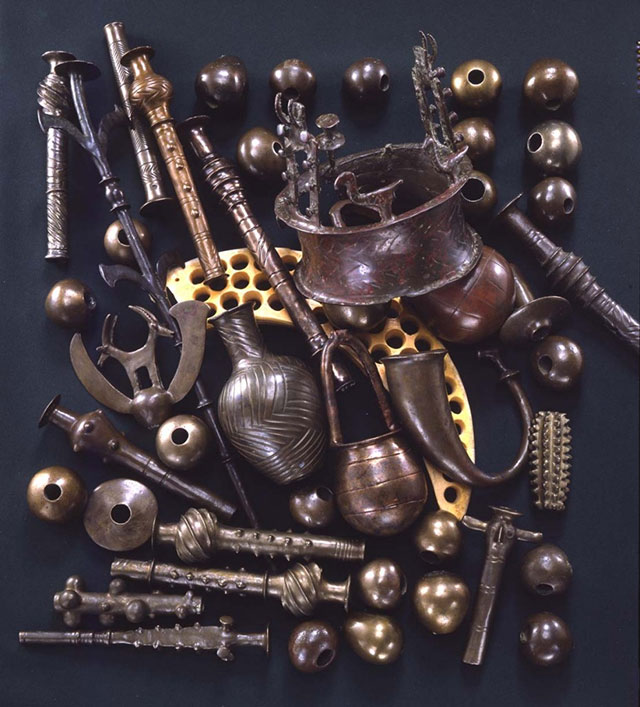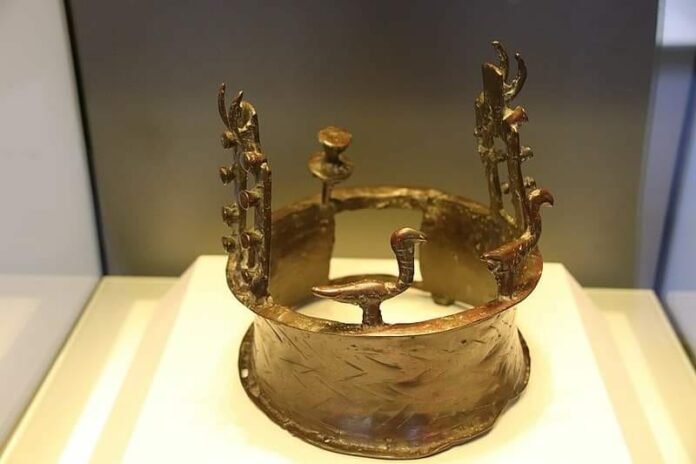The ancient world is filled with captivating stories of lost civilizations, hidden treasures, and remarkable discoveries that continue to captivate and intrigue us. One such tale is the unearthing of the oldest known crown in the world, a stunning artifact that sheds light on the rich cultural and religious practices of the Chalcolithic period in the Levant region. This remarkable crown, along with a trove of other priceless artifacts, was unveiled to the public in 2020 as part of the ‘Masters of Fire: Copper Age Art from Israel’ exhibit at the Institute for the Study of the Ancient World at New York University.
The Oldest Crown in the World

The crown in question, discovered in 1961 as part of the Nahal Mishmar Hoard, is a true marvel of ancient craftsmanship. Shaped like a thick ring, the crown features a series of striking protrusions along its rim, including vultures and what appear to be building facades with square openings. These enigmatic details suggest a deep connection to the burial practices and religious beliefs of the people who created this remarkable object.
According to the NYU exhibition, the crown was “an object of enormous power and prestige,” a visible symbol of the high status and authority of the individual who once wore it. This could have been a ruler, a religious figure, or a person of great importance within the social and political hierarchy of the time.
Artistic Motifs and Cultic Significance

The artifacts discovered in the Nahal Mishmar Hoard, including the crown, reveal a remarkable level of artistic sophistication and a deep connection to the religious and ceremonial practices of the Chalcolithic period. The forms and decorative motifs found on these objects, such as the fertility-related symbols, showcase the creative talents of the ancient artisans and the significance of these items within the cultural and spiritual life of the people.
The abundance and variety of the finds, which include mace heads, scepters, powder horns, tools, and weapons, suggest an organized socio-political and religious hierarchy, with widespread participation in rituals and festivals. The sheer weight and value of the copper objects highlight the priceless nature of this material during that time period, underscoring the importance of these artifacts within the cultural and economic landscape of the ancient Levant.
The Chalcolithic Temple and the Cave of Treasures

The Nahal Mishmar Hoard was discovered hidden in a natural crevice, wrapped in a straw mat, inside a cave on the northern side of the Nahal Mishmar river. This location, known as the ‘Cave of Treasures,’ has led to the intriguing suggestion that the artifacts may have been the sacred treasures belonging to the abandoned Chalcolithic Temple of Ein Gedi, located some 12 kilometers away.
The carbon-14 dating of the reed mat in which the objects were wrapped suggests that the hoard dates back to at least 3500 BC, a pivotal period in the Levant’s history when the use of copper became widespread, paralleling significant social and technological advancements in the region.
Significance and Impact

The discovery and study of the Nahal Mishmar Hoard, including the remarkable crown, have had a profound impact on our understanding of the cultural, religious, and technological developments of the Chalcolithic period. As Professor Daniel Master of Wheaton College noted, “The fascinating thing about this period is that a burst of innovation defined the technologies of the ancient world for thousands of years.”
Indeed, the artifacts in the hoard, with their unique and unprecedented designs, continue to captivate and inspire scholars and the public alike. As ISAW Exhibitions Director and Chief Curator Jennifer Chi eloquently stated, “To the modern eye, it’s stunning to see how these groups of people, already mastering so many new social systems and technologies, still had the ability to create objects of enduring artistic interest.”
Conclusion
The discovery of the oldest known crown in the world, along with the remarkable Nahal Mishmar Hoard, offers a glimpse into the rich cultural and religious heritage of the ancient Levant. This ancient crown, with its striking symbolism and craftsmanship, serves as a testament to the ingenuity, artistic prowess, and social complexity of the Chalcolithic people who lived in this region thousands of years ago. As we continue to unravel the mysteries of the past, the ancient majesty of this crown and the treasures it represents will undoubtedly continue to captivate and inspire scholars, historians, and the public alike.
